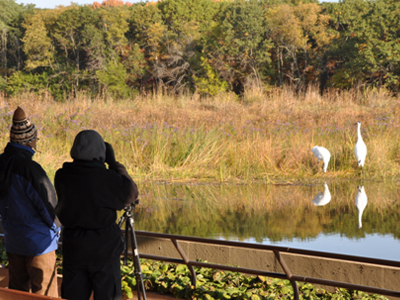By Megan Evansen, Naturalist
 As the seasons change, so do the patterns and behaviors of our captive flock. Things have been busy this fall within the Whooping Crane enclosure at ICF. We recently hosted Ph.D. student Megan Fitzpatrick, who spent a week here in Baraboo watching our Whooping Cranes, Omega and Seurat, and studying their behavior in a wetland environment.
As the seasons change, so do the patterns and behaviors of our captive flock. Things have been busy this fall within the Whooping Crane enclosure at ICF. We recently hosted Ph.D. student Megan Fitzpatrick, who spent a week here in Baraboo watching our Whooping Cranes, Omega and Seurat, and studying their behavior in a wetland environment.
Megan is completing her doctorate at the University of Wisconsin – Madison. She was previously an intern with ICF as a part of the Direct Autumn Release (DAR) program and the Crane Conservation Department. Though she gained interest in birds as an undergraduate, she came to love cranes through her time spent at ICF and was excited to continue her research on cranes through her doctorate program.
The goal of her project is to ultimately figure out how Whooping Cranes expend energy and create a model that predicts crane energy use. By knowing the basics of how they use energy throughout their day, Megan and her colleagues hope to answer other questions, such as whether or not Whooping Cranes build up fat reserves during the winter for use during nesting in the following spring. Some of the nest abandonment seen in Wisconsin may be due to Whooping Cranes not acquiring enough fat during winter months.
During her week at ICF, Megan and our Field Ecology interns have been following the movements of our exhibit Whooping Cranes from dawn until dusk, keeping a camera on them at all times (above). From this information, and from blood samples collected from the birds, she hopes to break down how they spend their day and compare that to the actual measured energy expenditure that occurred (this is done by injecting doubly labeled water molecules into the bird and then sampling the blood to determine how much energy the bird consumed during a specific period). Megan has also been gathering information on the composition of the birds’ food and weather conditions, all of which will help her figure out the energy balance cranes face. In knowing more about how food and changing climates affect the Whooping Crane, we can better estimate how the flux of yearly conditions affect these birds, as well as possibly eliminate theories on behaviors such as nest abandonment. Hopefully this information will provide further insight into how we can best protect this endangered species in the wild. We wish Megan great success with the rest of her research!
